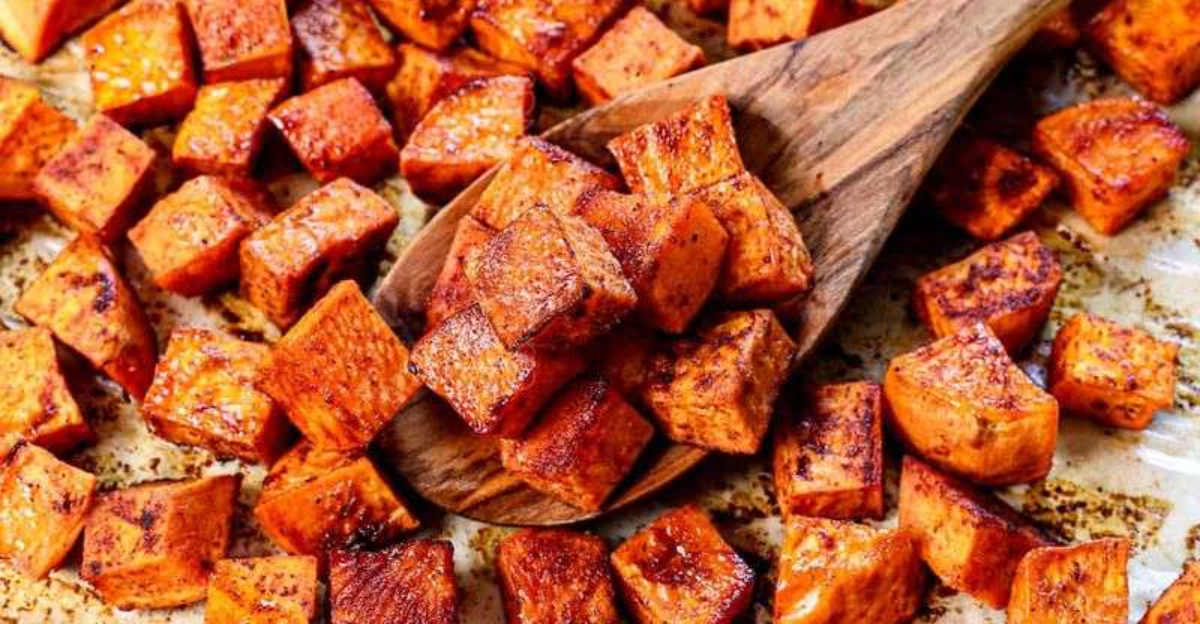18 Slip-Ups To Avoid When Cooking Sweet Potatoes

Sweet potatoes are delicious and versatile, but cooking them perfectly can sometimes feel tricky. A few simple mistakes can turn them from golden and tender to dry or mushy in no time.
Whether you’re baking, roasting, or mashing, knowing what to watch out for can save your meal from a flop.
Avoiding these common slip-ups means you’ll enjoy sweet potatoes at their very best every time, with all the flavor and texture you crave.
1. Skipping the Scrub Down
Those dirty sweet potatoes aren’t going to clean themselves! Soil harbors bacteria that can survive cooking temperatures.
A thorough wash under running water with a vegetable brush removes dirt from all the nooks and crannies.
Since many nutrients live right under the skin, proper cleaning lets you enjoy these benefits without eating actual earth.
2. Leaving Them Soaking Wet
Water and crispy sweet potatoes are sworn enemies! Moisture left on the surface creates steam during cooking instead of the caramelization you’re after.
Pat those orange beauties completely dry with paper towels before they hit any heat.
This simple step makes the difference between sad, soggy spuds and that delightful crunch we all crave from roasted sweet potatoes.
3. Playing Size Roulette
Random-sized sweet potato chunks cook at different rates, leaving you with burnt bits alongside raw pieces. Nobody wants that kitchen disappointment!
Take the extra minute to cut uniformly sized pieces. Your taste buds will thank you when every bite offers that perfect tender-yet-firm texture. Plus, evenly cut pieces create a more visually appealing dish that looks like you actually know what you’re doing.
4. Cramming Too Many in the Pan
Stuffing your baking sheet like a subway at rush hour guarantees steamed rather than roasted sweet potatoes. Each piece needs personal space!
When sweet potato pieces touch, they release steam and moisture that gets trapped. Spread them out in a single layer with breathing room between pieces.
This allows hot air to circulate around each one, creating that gorgeous caramelized exterior that makes sweet potatoes irresistible.
5. Rushing the Preheat
Tossing sweet potatoes into a cold oven is like jumping into a cold pool – shocking and unpleasant! Your spuds need that initial blast of consistent heat.
Preheat properly ensures even cooking from the moment they enter the oven.
Without this step, your sweet potatoes will steam in their own moisture before they start to roast, resulting in a texture that’s more mushy than magnificent.
6. Playing Temperature Guessing Games
Sweet potatoes are picky about temperature! Too low, and they turn out pale and lifeless. Too high, and you’ve got charcoal on the outside with raw centers.
The sweet spot is usually between 375°F and 425°F depending on your cooking method. This range allows the natural sugars to caramelize beautifully without burning, creating that perfect balance of crisp exterior and tender interior that makes sweet potatoes so crave-worthy.
7. Forgetting to Poke Holes
Unpierced sweet potatoes are basically ticking time bombs in your oven! Steam builds up inside with nowhere to escape.
Those few seconds it takes to stab your sweet potato several times with a fork prevents a volcanic eruption of sticky sweet potato guts all over your oven.
The holes allow steam to escape gradually during baking, helping the potato cook more evenly throughout while maintaining its shape.
8. Last-Minute Seasoning Sprinkle
Flavors need time to penetrate! Waiting until after cooking to add seasonings means they sit sadly on the surface instead of infusing throughout.
Season your sweet potatoes before they hit the heat. Salt, pepper, and spices have a chance to meld with the natural sugars as they cook.
This creates layers of flavor that transform a simple vegetable into something truly memorable.
9. Skimping on the Oil Coating
A proper oil coating isn’t just about preventing sticking – it’s essential for that gorgeous caramelization we all crave! Dry sweet potatoes will never reach their full potential.
Toss your sweet potato pieces in enough oil to give them a light, even coating. This conducts heat evenly across the surface and helps seasonings adhere better.
The result? Sweet potatoes with a perfectly crisp exterior that practically shatters when you bite into it.
10. Set It and Forget It Mentality
Sweet potatoes aren’t slow cooker meals! Neglecting to flip or rotate them during roasting leads to unevenly cooked pieces with one burnt side.
Take a moment halfway through cooking to give them a gentle toss or flip. This simple step ensures all sides get equal time facing the heat.
Your reward will be perfectly caramelized sweet potatoes with that ideal texture contrast between outside and inside.
11. Microwave-Only Method
Microwaves are convenient time-savers but terrible at creating texture! They steam sweet potatoes from the inside out, leaving you with none of that caramelized goodness.
Use the microwave as a head start if needed, but finish in the oven. Even just 10-15 minutes of oven time after microwaving can develop those complex flavors and textures that make sweet potatoes special.
12. Pulling Them Too Soon
Sweet potatoes continue cooking after leaving the heat! Yanking them out the moment they seem done means they’ll firm up as they cool.
Account for carryover cooking by removing them just before they reach perfection.
Let them rest for a few minutes to complete the cooking process naturally. This patience pays off with sweet potatoes that maintain their ideal texture from first bite to last.
13. Oil Temperature Confusion
Not all oils are created equal in the sweet potato world! Using the wrong oil can result in bitter, smoky disasters when high heat breaks down oils with low smoke points.
For high-temperature roasting (above 400°F), reach for avocado oil, refined coconut oil, or ghee. Save your beautiful olive oil for lower temperature cooking or finishing.
The right oil makes all the difference between sweet potatoes that taste clean and caramelized versus those with an off-putting burnt flavor.
14. Naked Rack Baking Blunder
Sweet potatoes ooze sticky sugars as they bake! Placing them directly on the oven rack without protection means you’ll be scraping caramelized syrup off your oven for days.
Always use foil or a baking sheet underneath. This simple barrier catches all those delicious juices that would otherwise become burnt-on messes.
Your future self will thank you when cleanup takes seconds instead of requiring a chisel and determination.
15. Bland Seasoning Syndrome
Sweet potatoes have natural sweetness, but that doesn’t mean they don’t need help in the flavor department! Underseasoning is a missed opportunity for greatness.
Don’t be shy with salt – it actually enhances sweetness while balancing the flavors. Experiment with complementary spices like cinnamon, smoked paprika, or cumin.
Even the skin becomes deliciously edible when properly seasoned, adding texture and nutrients to your dish.
16. Ignoring Potato Imperfections
Nobody wants to bite into a sweet potato and find a surprise green spot or sprouting eye! These blemishes can range from unpleasant to potentially harmful.
Take a moment to trim away any dark spots, sprouts, or green areas before cooking.
The skin of sweet potatoes is nutritious and delicious when cleaned properly, but those questionable areas should get the knife treatment. Your dinner guests will appreciate your attention to detail.
17. Paper-Thin Slicing Disaster
Those ultra-thin sweet potato slices might look fancy, but they’re heading for burnt chip territory! Too-thin slices go from raw to charred in seconds.
For fries and chips, aim for at least ¼-inch thickness. This gives them structure to hold up during cooking while still crisping nicely on the outside.
The sweet spot thickness ensures they’ll cook through properly without disintegrating or burning before the centers are done.
18. Rushing the Rest Period
Serving sweet potatoes straight from the oven robs them of their full flavor potential! Just like meat, these veggies benefit from a brief rest before serving.
Give them 5-10 minutes to cool slightly after cooking. During this time, the internal temperature stabilizes, flavors concentrate, and the texture settles to perfection.
This short wait transforms good sweet potatoes into great ones, with deeper flavor and improved mouthfeel.
